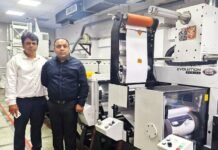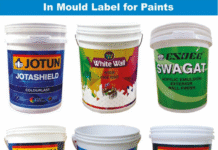“One of our major focus areas is pharmaceutical labelling and Hyderabad is a pharmaceu- tical hub. A lot of major pharma companies have manufacturing units in and around Hyderabad. Overthe years, we have been supplying our products to Hyderabad from our Mumbai plant and now we have decided to get closer to our customers,” says Amar Chhajed, managing director of Webtech Labels. He also stated that the Hyderabad plant is a state-of-the-art plant spread across 40,000 square feet. The equipment installed in the plant includes a new 8-color Gallus EM 280, which has been imported from Switzerland.
Quality control is taken care of by 100% defect detection systems from AVT in Israel with finishing equipment from Rotoflex and Prati.
The new plantis built according to the latest good manufacturing practice (GMP) norms and is accreditedwithanISO9001-2008 certification. Webtech Labels has recently started the production and supply of labels to few of the most reputed pharmaceutical companies in Hyderabad region. The production capacity of the new plant will be around 2 million square metres per annum. Moreover, Webtech Labels, plans to double the capacity by installing one more press in the plant. Our key strength of offering innovative labelling solutions at the shortest lead times to all our customers will be replicated at the Hyderabad plant.”
Speaking about the challenges faced by the label industry, Chhajed said, “Competition on price is the biggest challenge as there are many new entrants and existing players who compromise on the price. If we want to survive we need to make profit as well as the money for investment in one of the world`s leading technology. If you don’t price the products properly, you will not be able to recover your investment and then you cannot reinvest. With upcoming technologies the quality of printing will be enhanced and that helps to provide better print quality to customers, which is comparable to offset or gravure.”
On the future trends, Chhajed said, “Digital printing is picking up and may soon become aviable proposition asan independent business. He also expressed his interest in the hybrid machines including flexography and digital as the latest trend in printing machines. For consistency in print quality, a lot of development is observed in color standardization. It is difficult to make the client understand that instead of pantone, one must optfor process colors. A mutual understanding has to be arrived at amongst the customers, converters and press manufacturers on color management.”
“For sustainability, we have aggressively promoted the PET liner, as it reduces the carbon footprint because the glassine paper is basically landfill and the PET liner is 100% recyclable. Webtech has been reusing the printing waste material as a useful product for packaging,” concludes Chhajed.











